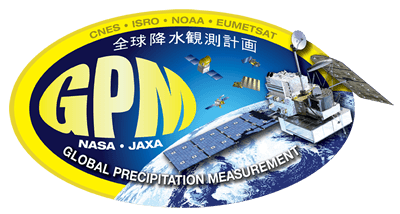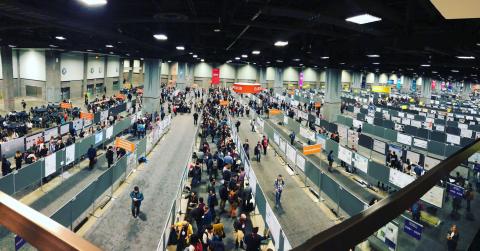 The Global Hydrology Resource Center Distributed Active Archive Center (GHRC DAAC) published a Python-based data recipe enabling users to compile information from a series of NRT AMSR2 Swath data files and generates a CSV file containing surface precipitation rates with locations to enable use with other software. The data recipe and associated code may be accessed here: https://ghrc.nsstc.nasa.gov/home/data-recipes/lance-nrt-amsr2-l2b-global...
The Global Hydrology Resource Center Distributed Active Archive Center (GHRC DAAC) published a Python-based data recipe enabling users to compile information from a series of NRT AMSR2 Swath data files and generates a CSV file containing surface precipitation rates with locations to enable use with other software. The data recipe and associated code may be accessed here: https://ghrc.nsstc.nasa.gov/home/data-recipes/lance-nrt-amsr2-l2b-global...
GHRC News
 The NASA Global Hydrology Resource Center (GHRC) DAAC published the GPM Ground Validation Met One Rain Gauge Pairs Wallops Flight Facility (WFF) dataset. This dataset contains rain rate data from 4 rain gauge networks located in Virginia and Maryland near the Wallops Flight Facility (WFF): Nassawadox, Pocomoke, HalfDeg and Wallops Flight Facility (WFF) Assorted Gauges. These data were collected in support of the Global Precipitation Mission (GPM) Ground Validation (GV) campaign. The Met One Rain Gauge Pairs are tipping bucket precipitation gauges which collect precipitation amounts and calculate rain rates. The dataset contains 3 products: formatted gauge tips (GAG), interpolated one-minute rain rates for a year (GMIN), and interpolated one-minute rain rates for a month (2A56). Data are available in ASCII format for the period of April 10, 2012 through October 1, 2018.
The NASA Global Hydrology Resource Center (GHRC) DAAC published the GPM Ground Validation Met One Rain Gauge Pairs Wallops Flight Facility (WFF) dataset. This dataset contains rain rate data from 4 rain gauge networks located in Virginia and Maryland near the Wallops Flight Facility (WFF): Nassawadox, Pocomoke, HalfDeg and Wallops Flight Facility (WFF) Assorted Gauges. These data were collected in support of the Global Precipitation Mission (GPM) Ground Validation (GV) campaign. The Met One Rain Gauge Pairs are tipping bucket precipitation gauges which collect precipitation amounts and calculate rain rates. The dataset contains 3 products: formatted gauge tips (GAG), interpolated one-minute rain rates for a year (GMIN), and interpolated one-minute rain rates for a month (2A56). Data are available in ASCII format for the period of April 10, 2012 through October 1, 2018.
This animation is from July 13, 2018 and observes a single flash over northwestern Columbia and lasted for almost 1.5 seconds. The flash was observed by the International Space Station Lightning Imaging Sensor (ISS-LIS) that is the flight spare for the original Tropical Rainfall Measuring Mission (TRMM) satellite. This instrument has been extremely valuable for validating the Geostationary Lightning Mapper (GLM) on the new GOES-R series of satellites (GOES-16 and -17) as the GLM is based on the LIS design and the 20+ year heritage of NASA space-based lightning mapping technologies. The key value of ISS-LIS, however, is its orbit that allows the detection lightning in parts of the globe that have not been observed since the OTD era (April 1995-March 2000). In addition, the ISS-LIS has a comparable altitude to TRMM-LIS and can measure lightning in the mid-to-high latitudes with approximately the same precision as TRMM-LIS in the low latitudes. This enables scientists to examine how lightning varies by region and changes according to the local climate regime. The case shown here is one of the largest flashes observed by ISS-LIS so far. This is a propagating flash that develops from east to west with notable recoil processes resulting in a wave of radiant energy (i.e., light being observed by the instrument) retracing the lightning channel (dark lines). LIS provides insights into lightning physics that will be valuable for understating electrical processes in the most unique thunderstorms around the world from oceanic convection to the extremely shallow storms that develop with super-cold Siberian cold air outbreaks. This animation was created by GHRC User Working Group member Dr. Michael Peterson.
 The NASA Global Hydrology Resource Center (GHRC) DAAC published the GPM Ground Validation Multi-Radar/Multi-Sensor (MRMS) Precipitation Reanalysis for Satellite Validation Product dataset. This dataset contains precipitation rate and type estimates, quality control products, and precipitation corrective factors products. These data products were created using the NOAA MRMS System which ingests Weather Surveillance Radar 88 Doppler (WSR-88D) radar data, Rapid Update Cycle (RAP) model analysis fields, and gauge data. It should be noted that these data products are not standard MRMS. Significant post-processing is applied to MRMS to generate products specifically adapted to satellite purposes and needs over North America. These data are available from March 2, 2014 through October 30, 2018 in ASCII format.
The NASA Global Hydrology Resource Center (GHRC) DAAC published the GPM Ground Validation Multi-Radar/Multi-Sensor (MRMS) Precipitation Reanalysis for Satellite Validation Product dataset. This dataset contains precipitation rate and type estimates, quality control products, and precipitation corrective factors products. These data products were created using the NOAA MRMS System which ingests Weather Surveillance Radar 88 Doppler (WSR-88D) radar data, Rapid Update Cycle (RAP) model analysis fields, and gauge data. It should be noted that these data products are not standard MRMS. Significant post-processing is applied to MRMS to generate products specifically adapted to satellite purposes and needs over North America. These data are available from March 2, 2014 through October 30, 2018 in ASCII format.Leigh Sinclair and Ajinkya Kulkarni from the NASA Global Hydrology Resource Center (GHRC) DAAC attended the American Geophysical Union (AGU) Fall Meeting in Washington, D.C. where four posters were presented. Leigh conducted a lightning talk at the NASA Hyperwall titled “Application of ISS Lightning Data to Improve Hazardous Weather Preparation”, as well as chaired an oral session. Ajinkya conducted an oral presentation titled “Challenges Deploying Legacy Software in the Cloud”. You can find the posters presented at https://www.itsc.uah.edu/main/outreach/posters for a closer look.








